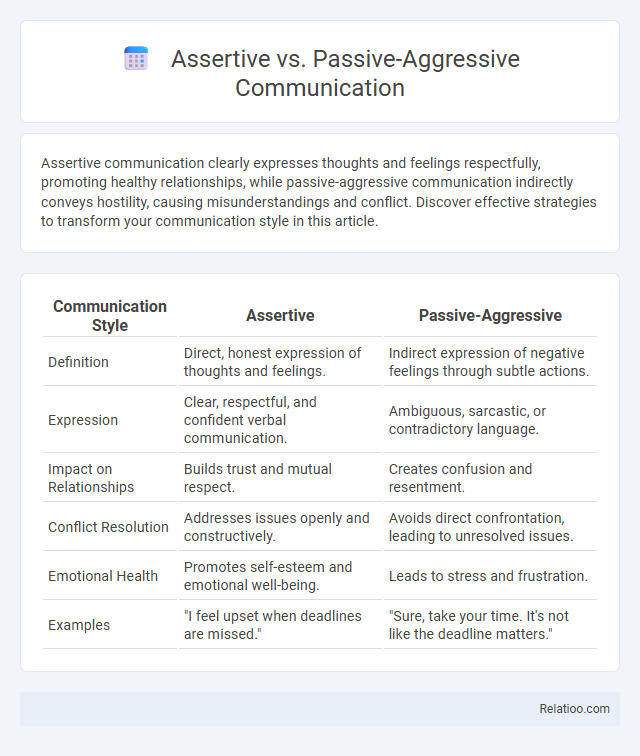Assertive communication clearly expresses thoughts and feelings respectfully, promoting healthy relationships, while passive-aggressive communication indirectly conveys hostility, causing misunderstandings and conflict. Discover effective strategies to transform your communication style in this article.
Table of Comparison
| Communication Style | Assertive | Passive-Aggressive |
|---|---|---|
| Definition | Direct, honest expression of thoughts and feelings. | Indirect expression of negative feelings through subtle actions. |
| Expression | Clear, respectful, and confident verbal communication. | Ambiguous, sarcastic, or contradictory language. |
| Impact on Relationships | Builds trust and mutual respect. | Creates confusion and resentment. |
| Conflict Resolution | Addresses issues openly and constructively. | Avoids direct confrontation, leading to unresolved issues. |
| Emotional Health | Promotes self-esteem and emotional well-being. | Leads to stress and frustration. |
| Examples | "I feel upset when deadlines are missed." | "Sure, take your time. It's not like the deadline matters." |
Understanding Assertive Communication
Assertive communication involves expressing your thoughts and feelings clearly and respectfully, promoting open dialogue and mutual understanding. This style contrasts with passive-aggressive communication, which disguises negative emotions through indirect, often ambiguous remarks, leading to confusion and conflict. Mastering assertive communication can enhance your relationships by fostering honesty and reducing misunderstandings.
Defining Passive-Aggressive Communication
Passive-aggressive communication involves expressing negative feelings indirectly rather than openly addressing them, often through sarcasm, procrastination, or subtle sabotage. You may appear cooperative on the surface while harboring resentment or hostility beneath, which leads to misunderstandings and unresolved conflicts. Understanding passive-aggressive behavior is essential for fostering clearer, more honest communication and healthier relationships.
Key Differences Between Assertive and Passive-Aggressive Styles
Assertive communication involves expressing Your thoughts and feelings clearly and respectfully, promoting open dialogue and mutual understanding. Passive-aggressive communication, on the other hand, hides true emotions behind indirect expressions, often leading to confusion and unresolved conflict. Key differences include directness, emotional honesty, and the impact on relationships, with assertiveness fostering trust and passive-aggressiveness undermining it.
Psychological Roots of Assertive and Passive-Aggressive Behavior
Assertive communication stems from a foundation of healthy self-esteem and clear emotional awareness, enabling individuals to express their needs and boundaries openly and respectfully. Passive-aggressive behavior often originates from unresolved frustration, fear of confrontation, and feelings of powerlessness, leading to indirect expressions of hostility and resentment. Understanding these psychological roots highlights the contrast between proactive emotional regulation in assertive individuals and the underlying anxiety or insecurity driving passive-aggressive responses.
Common Examples in Everyday Life
Assertive communication involves expressing your needs clearly and respectfully, such as stating your opinions during a team meeting or setting boundaries with a friend. Passive-aggressive communication often appears as indirect resistance or subtle sabotage, like agreeing to a request but intentionally missing deadlines or giving silent treatment instead of expressing dissatisfaction. Recognizing these patterns can improve your interactions and help you address misunderstandings effectively.
Effects on Relationships and Team Dynamics
Assertive communication fosters trust, clarity, and mutual respect in relationships by promoting open and honest dialogue, which enhances team collaboration and productivity. Passive-aggressive communication often leads to misunderstandings, resentment, and decreased morale, undermining team cohesion and causing conflicts to fester. Your ability to engage assertively ensures healthier interactions and more effective teamwork by addressing issues directly and constructively.
Benefits of Assertive Communication
Assertive communication promotes clear expression of thoughts and feelings while respecting others, leading to healthier relationships and reduced misunderstandings. You benefit from increased confidence, improved conflict resolution, and enhanced emotional well-being through assertive communication. Unlike passive-aggressive communication, assertiveness fosters direct dialogue, preventing resentment and fostering trust.
Drawbacks of Passive-Aggressive Communication
Passive-aggressive communication often leads to misunderstanding and unresolved conflicts due to its indirect expression of anger or dissatisfaction. This communication style can damage trust and reduce productivity by fostering resentment and confusion among team members or within personal relationships. Unlike assertive communication, which promotes clear and honest dialogue, passive-aggressive behavior hinders effective problem-solving and emotional transparency.
Identifying Your Communication Style
Identifying your communication style involves recognizing patterns such as clear, direct expression in assertive communication versus indirect, manipulative behavior in passive-aggressive communication. Assertive individuals communicate openly and respectfully, while passive-aggressive communicators express hidden anger through sarcasm or procrastination. Understanding these distinctions aids in improving interpersonal relationships and conflict resolution.
Tips for Developing Assertive Communication Skills
Developing assertive communication skills involves clearly expressing your thoughts and feelings while respecting others, which helps you build healthy relationships and reduces misunderstandings. You can practice using "I" statements to take ownership of your emotions and avoid blame, ensuring your message is direct and constructive. Consistent self-awareness and active listening play crucial roles in maintaining assertiveness without slipping into passive-aggressive or passive communication patterns.

Infographic: Assertive vs Passive-aggressive communication
 relatioo.com
relatioo.com